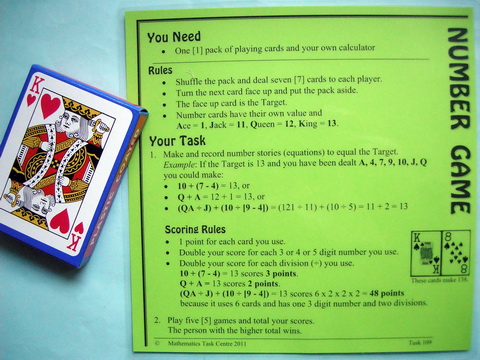
Number GameTask 109 ... Years 4 - 8SummaryDeal a few cards to each player. Add a few rules about how to make equations and you have great game, which, through the fall of the cards, levels the playing field for students of different ability and yet is always open to amazing numerical creativity. The rules of the game as presented are designed to encourage the use of multiplication and division knowledge. The mathematician's question What happens if...? encourages students to change the rules to develop their own form of the game. This is exactly what has happened in a television game show which, at time of writing, appears on the SBS network in Australia under the title of Letters and Numbers. With sufficient interest in the Number Game form, teachers might consider an in-school tournament.This cameo includes an Investigation Guide. |
Materials
Content
|

IcebergA task is the tip of a learning iceberg. There is always more to a task than is recorded on the card. |
Students first need to realise that the rules encourage a special way of using the cards that isn't found in similar games. Usually the face value of the cards is all that matters when creating equations, but in this case place value is also allowed. There are two examples on the card designed to make students ask What's going on here? without actually telling them.
That sorted, the game offers students at any level a chance to play and be creative. There is enough probability in the game to give less able players some chance of success against more able mathematicians. However those who are able to move the cards around, think up, and evaluate, the various possibilities, will be sure to succeed in the long run. Clearly students will be expected to demonstrate their number stories to each other, and in so doing they must show correct use of operations and the rules for the order of operations. Scoring rules are designed to encourage the use of larger numbers and division, ie: use of tables! Students who have experienced Cribbage, a member activity from Calculating Changes will be well prepared for this phase. The teacher should determine whether calculators are allowed, and act as arbitrator in the case of disputes. Experience suggests that a time limit should be placed on each deal. In a sense, the game is its own iceberg, since every deal is a new challenge. To lead investigation further use the Investigation Guide which is along the same theme of combining numbers creatively to reach given targets. An Investigation Guide prepared by the teacher is one of the three lives of a task and this example is provided to support teachers in developing their own guides for other tasks. It was first used in the Lower Secondary Computation Replacement Unit, which is now superseded by Maths With Attitude. Students who enjoy the challenge of trying to find expressions with particular values will have plenty to do on this sheet. There is no doubt that having cards will help in allowing the mind to create the expressions. Encourage them to use any aids that will make the task easier. The Answer Guide for teachers is also available. Once they get started, the task begins to flow. This is partly because it is possible to use previous solutions to find combinations that will work in the future. One very useful idea is that if you have (expression - 1), then you can follow it with (expression x 1) and (expression + 1). Led by the Investigation Guide, teachers might also suggest students change the game into an investigation by reducing the number of cards, for example to three and a Turn Up card, then asking the mathematician's questions:
|
Whole Class InvestigationTasks are an invitation for two students to work like a mathematician. Tasks can also be modified to become whole class investigations which model how a mathematician works. |
One way to turn this task into a whole class investigation is for the teacher to deal the cards and the Turn Up. Using a large size deck of cards (available in some game shops) works well because the cards can be placed for public viewing along the white board ledge. The challenge is then on for each team to earn the highest total from the same set of cards. The Investigation Guide can be also be used in this environment to celebrate mathematical creativity and focus class discussion on the range of possible answers in each case.
At this stage, Number Game does not have a matching lesson on Maths300. |
Is it in Maths With Attitude?Maths With Attitude is a set of hands-on learning kits available from Years 3-10 which structure the use of tasks and whole class investigations into a week by week planner. |
The Number Game task is an integral part of:
|